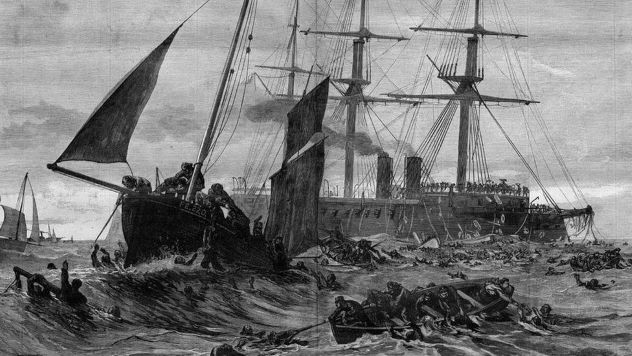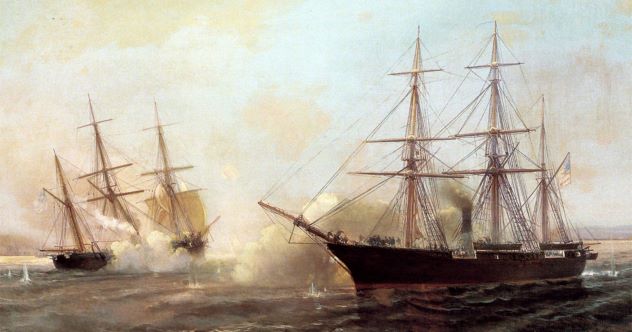 Weird Stuff
Weird Stuff  Weird Stuff
Weird Stuff  Our World
Our World 10 Ways Your Christmas Tree Is More Lit Than You Think
 Movies and TV
Movies and TV The 10 Coolest Stars to Set Sail on The Love Boat
 History
History 10 Things You Didn’t Know About the American National Anthem
 Technology
Technology Top 10 Everyday Tech Buzzwords That Hide a Darker Past
 Humans
Humans 10 Everyday Human Behaviors That Are Actually Survival Instincts
 Animals
Animals 10 Animals That Humiliated and Harmed Historical Leaders
 History
History 10 Most Influential Protests in Modern History
 Creepy
Creepy 10 More Representations of Death from Myth, Legend, and Folktale
 Technology
Technology 10 Scientific Breakthroughs of 2025 That’ll Change Everything
 Weird Stuff
Weird Stuff Ten Bizarre Facts About The Doge Meme
 Our World
Our World 10 Ways Your Christmas Tree Is More Lit Than You Think
 Movies and TV
Movies and TV The 10 Coolest Stars to Set Sail on The Love Boat
Who's Behind Listverse?

Jamie Frater
Head Editor
Jamie founded Listverse due to an insatiable desire to share fascinating, obscure, and bizarre facts. He has been a guest speaker on numerous national radio and television stations and is a five time published author.
More About Us History
History 10 Things You Didn’t Know About the American National Anthem
 Technology
Technology Top 10 Everyday Tech Buzzwords That Hide a Darker Past
 Humans
Humans 10 Everyday Human Behaviors That Are Actually Survival Instincts
 Animals
Animals 10 Animals That Humiliated and Harmed Historical Leaders
 History
History 10 Most Influential Protests in Modern History
 Creepy
Creepy 10 More Representations of Death from Myth, Legend, and Folktale
 Technology
Technology 10 Scientific Breakthroughs of 2025 That’ll Change Everything
10 Lesser-Known Ships That Sank During Their Maiden Voyages
We’re all familiar with the story of the RMS Titanic, the British passenger liner that hit an iceberg in the Atlantic ocean and sank during her maiden voyage in 1912. What few people realize, however, is that the Titanic was not the first ship to sink during its first journey, and by no means the last. Some faced a similarly overwhelming number of casualties, while others were more fortunate.
From German battleships to Dutch trading vessels, here are ten lesser-known ships that sank during their maiden voyages.
Related: Top 10 Remarkable Finds Involving Old Ships And Explorers
10 MS Zenobia (1979)
Close to the harbor of Larnaca in Cyprus, the wreck of the MS Zenobia lies 42 meters (138 feet) beneath the azure surface of the Mediterranean Sea. This Swedish-built ferry was put into service in late 1979, leaving on her maiden voyage from Malmö to Tartous in Syria in May 1980. While just off of Larnaca, early in the morning of June 2, 1980, the ship started to list. During the following five days, every possible effort was made to save her. However, in the early hours of June 7, she finally capsized and sank.
The most likely cause of the Zenobia’s sinking was her computerized ballasting system, which had caused reoccurring problems. Engineers discovered that a software error caused the system to pump excess water into the side ballast tanks. When this finally caused the ship to sink, cargo worth millions was taken with her, but remarkably, there were no casualties.[1]
9 SMS Grosser Kurfürst (1875)

Built for the German Kaiserliche Marine, SMS Grosser Kurfürst was an ironclad turret ship that took eight years to complete. First laid down at the Imperial Dockyard in 1870, she was officially launched in 1875 but only fully completed three years later.
Steaming through the English Channel during her maiden voyage in May 1878, Grosser Kurfürst was accompanied by two other ships: the ironclad SMS König Wilhelm and SMS Preussen. When they encountered a group of fishing boats under sail, the three ships quickly turned to avoid them. In so doing, Grosser Kurfürst was rammed by König Wilhelm after accidentally crossing her path. Sinking within just eight minutes, over half of her 500-man crew were lost.[2]
8 RMS Tayleur (1854)
Often described as “the first Titanic,” the RMS Tayleur was a full-rigged iron clipper ship chartered to serve the Australian trade routes. Built in just six months, she left Liverpool in England for her maiden voyage in January 1854. Within 48 hours of setting off, the crew believed that they were sailing through the Irish Sea but were, in fact, traveling westwards toward Ireland. It was later found that the ship’s compasses hadn’t worked properly due to the iron hull, so she had headed straight for the island of Lambay while caught in thick fog and storms. With an undersized rudder and slack rigging added to the mix, she ran aground on the east coast of the island.
Unable to lower the lifeboats without them smashing onto the rocks, the crew collapsed a mast onto the shore so that passengers could escape by clambering along it. Some of these individuals had carried ropes from the ship, which they then used to pull others to safety. The ship’s 29-year-old captain waited on board until the sea consumed her, leaving just the tops of her masts showing. After being alerted by a surviving passenger, the coast guard made their way to the wreck, where they encountered the last survivor. A man named William Vivers had managed to climb to the top of the rigging, where he waited 14 hours to be rescued. Of more than 650 passengers who had been on board when the Tayleur set sail, only 280 survived.[3]
7 CSS Georgiana (1863)

This Confederate steamer was supposed to be one of the best-armed vessels in the Confederate Fleet. The SS Georgiana was built in Scotland before setting sail on its maiden voyage in 1863. Headed for South Carolina, she was due to be fitted out with the guns stored in the hold once she reached Charleston. However, as she approached her destination on March 19, she was met by the yacht America, which swiftly alerted the nearby battleship USS Wissahickon. With all her guns and defenses in storage, she was completely defenseless against the warship’s large guns, which quickly pierced the hull.
With the propeller and rudder destroyed and the hull quickly taking in water, the Georgiana’s captain signaled a surrender before breaching the boat. He then purposefully sank it to prevent it from being boarded before escaping to land with the entire crew. Furious that they wouldn’t be able to gain a reward for capturing the steamer, the Wissahickon crew set her on fire to prevent any looters from salvaging the cargo. The Georgiana was finally lost after burning and taking on water for several days.[4]
6 RMS Magdalena (1948)
The RMS Magdalena was a passenger and refrigerated cargo ocean liner built in Belfast in 1948. She was built as a replacement for a ship that had been lost in 1940 and was to serve the route between England and South America. Bound for Buenos Aires, she set forth on her maiden voyage in March 1949.
In the early hours of April 25, the Magdalena approached Rio de Janeiro. Her crew found that she was half a nautical mile too far north of her intended position and took measures to correct it to not hit the Tijucas Rocks. Nevertheless, she hit them after the Third Officer mistook them for a ship without lights, then failed to sufficiently maneuver in time. The Brazilian Navy responded to the Magdalena’s SOS forecast by sending three chasers and three submarine destroyers. After many passengers were rescued, attempts were made to refloat the ship and tug her into Rio de Janeiro. She soon split in two, however, and both sections now lay just 11–13 meters (36–42 feet) beneath the waters of Guanabara Bay. While much of the cargo was salvaged, hundreds of oranges that had been on the Magdalena later washed up on Copacabana Beach.[5]
5 RMS Amazon (1851)
The RMS Amazon was a wooden paddle steamer and Royal Mail Ship built in London to serve routes between Southampton and the Caribbean. The Amazon set sail on her maiden voyage on January 2, 1852, loaded with mail, expensive cargo, and 50 passengers. Within the first 24 hours, she came to a standstill twice after her engine bearings overheated. Then, upon entering the Bay of Biscay on January 4, she caught fire.
The fire quickly intensified to the extent that the engine rooms could no longer be reached. With the crew unable to stop the engines, the ship raced on during attempts to launch the lifeboats. Repeated efforts to lower them caused most of the occupants to be tossed into the water. The fire soon brought down the ship’s fore and mainmast, and the deck collapsed after the explosion of her magazine brought down the mizzen mast. Glowing red-hot, she finally sank about thirty minutes later, just off the coast of the Isles of Scilly.[6]
4 KMS Bismarck (1941)
Intended to herald the rebirth of the German surface battle fleet, the state-of-the-art battleship Bismarck was launched at Hamburg on February 14, 1939. However, it wasn’t until two years later that she was able to make her maiden voyage. The British had been closely guarding ocean routes against Germany since the outbreak of the Second World War, meaning only U-Boats could move freely through the war zone. In May 1941, the Bismarck finally broke out into the Atlantic Ocean. Knowing that she would be impossible to track down in the open water and likely cause devastation on Allied convoys, the British sent almost their entire Home Fleet in pursuit.
The British Battleships Hood and Prince of Wales intercepted the Bismarck near Iceland, and a raging battle ensued. In a ferocious exchange, the Hood lost all but three of its 1,421 crew after she exploded and sank. Leaking fuel, the Bismarck then fled for occupied France but was soon sighted and attacked by British aircraft. Three British warships were then able to descend upon the Bismarck to inflict heavy damage. With numerous fires aboard, the pride of the German navy was soon unable to steer and listing severely, rendering her guns almost completely useless. The Bismarck quickly sank after the command went out to scuttle her, leaving only 115 of her 2,221 crew to survive.[7]
3 MS Georges Philippar (1932)
Completed in January 1932, the ocean liner Georges Philippar was constructed for France’s Compagnie des Messageries Maritimes. The ship’s maiden voyage from Marseilles to China and Japan commenced in February 1932, despite prior threats made against her.
On May 16, as the Georges Philippar approached the Horn of Africa during her homeward run, a fire broke out in a piece of electrical equipment. Despite cutting power from the affected section of the ship, the fire spread rapidly, filling the cabins and passageways with dense smoke and affecting communications. She was brought to a stop to enable the lifeboats to be lowered, and while she listed, the order was given to abandon ship. The lifeboats had to be hosed down while they were launched to prevent them from being consumed by the flames. Many of the passengers even had to leap directly into the ocean to avoid the blaze, particularly those who had become trapped in their cabins. After being completely abandoned, the Georges Philippar drifted for a while before finally sinking to the depths of the ocean.[8]
2 Batavia (1628)
Built in Amsterdam in 1628, the Batavia was the new flagship of the Dutch East India Company. She set sail on her maiden voyage in October 1628, headed for the Dutch East Indies. Valuable cargo and 340 passengers were on board, as well as a huge supply of trade gold and silver. What was to ensue has become known as one of the worst horror stories in maritime history.
A bankrupt merchant named Jeronimus Cornelisz was present on board and, together with a small number of the crew, planned a brutal mutiny. A crew member deliberately steered the ship off course, which caused her to hit Morning Reef near Beacon Island off the coast of Australia. Approximately forty people drowned as the ship sank, while the remaining passengers and crew were able to get ashore. With no water and limited food on the islands they were marooned on, the captain and his crew took off in a longboat to search for water.
As one of the survivors left behind, Cornelisz designated himself as the leader and gathered a band of supporters and fellow mutineers to help him eliminate any opponents. Together, they brutally murdered around 125 of the men, women, and children who had survived the wreck, keeping a small number of women as sex slaves. When the Batavia’s captain was eventually able to return with help, the mutineers were quickly arrested and later executed. Only one-third of the original passengers had survived Cornelisz’s atrocities.[9]
1 Vasa (1628)
The vast, ornately decorated Swedish ship Vasa was the world’s most advanced warship when she set sail from Stockholm in 1628. Carrying an unprecedented number of bronze cannons and covered in intricate wooden carvings, the ship was celebrated by a huge public crowd that had gathered to see her embark on her maiden voyage. Just twenty minutes after setting sail, however, they watched on, horrified, as a strong gust of wind caused Europe’s most ambitious warship to topple over and sink.
A later inquest found that the ship had been too unstable, likely because the gun deck was far too heavy. This was probably the result of being designed and built by someone with no experience in building such a well-armed ship, as well as the construction being rushed by the king. The Vasa was raised intact in 1961 and, perfectly preserved, can be visited today in Stockholm’s Vasa Museum.[10]



![11 Lesser-Known Facts About Mass Murderer Jim Jones [Disturbing Content] 11 Lesser-Known Facts About Mass Murderer Jim Jones [Disturbing Content]](https://listverse.com/wp-content/uploads/2020/09/jonestown2-copy-150x150.jpg)




